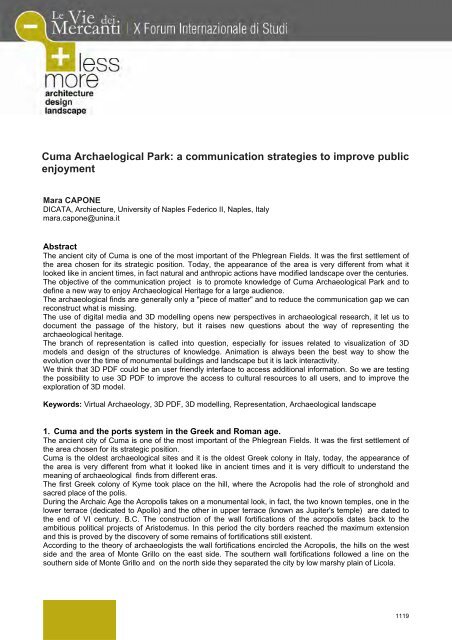Archaeology and nature: hyblean cultural landscape and territorial ...
Archaeology and nature: hyblean cultural landscape and territorial ...
Archaeology and nature: hyblean cultural landscape and territorial ...
You also want an ePaper? Increase the reach of your titles
YUMPU automatically turns print PDFs into web optimized ePapers that Google loves.
Cuma Archaelogical Park: a communication strategies to improve public<br />
enjoyment<br />
Mara CAPONE<br />
DICATA, Archiecture, University of Naples Federico II, Naples, Italy<br />
mara.capone@unina.it<br />
Abstract<br />
The ancient city of Cuma is one of the most important of the Phlegrean Fields. It was the first settlement of<br />
the area chosen for its strategic position. Today, the appearance of the area is very different from what it<br />
looked like in ancient times, in fact natural <strong>and</strong> anthropic actions have modified l<strong>and</strong>scape over the centuries.<br />
The objective of the communication project is to promote knowledge of Cuma Archaeological Park <strong>and</strong> to<br />
define a new way to enjoy Archaeological Heritage for a large audience.<br />
The archaeological finds are generally only a "piece of matter" <strong>and</strong> to reduce the communication gap we can<br />
reconstruct what is missing.<br />
The use of digital media <strong>and</strong> 3D modelling opens new perspectives in archaeological research, it let us to<br />
document the passage of the history, but it raises new questions about the way of representing the<br />
archaeological heritage.<br />
The branch of representation is called into question, especially for issues related to visualization of 3D<br />
models <strong>and</strong> design of the structures of knowledge. Animation is always been the best way to show the<br />
evolution over the time of monumental buildings <strong>and</strong> l<strong>and</strong>scape but it is lack interactivity.<br />
We think that 3D PDF could be an user friendly interface to access additional information. So we are testing<br />
the possibility to use 3D PDF to improve the access to <strong>cultural</strong> resources to all users, <strong>and</strong> to improve the<br />
exploration of 3D model.<br />
Keywords: Virtual <strong>Archaeology</strong>, 3D PDF, 3D modelling, Representation, Archaeological l<strong>and</strong>scape<br />
1. Cuma <strong>and</strong> the ports system in the Greek <strong>and</strong> Roman age.<br />
The ancient city of Cuma is one of the most important of the Phlegrean Fields. It was the first settlement of<br />
the area chosen for its strategic position.<br />
Cuma is the oldest archaeological sites <strong>and</strong> it is the oldest Greek colony in Italy, today, the appearance of<br />
the area is very different from what it looked like in ancient times <strong>and</strong> it is very difficult to underst<strong>and</strong> the<br />
meaning of archaeological finds from different eras.<br />
The first Greek colony of Kyme took place on the hill, where the Acropolis had the role of stronghold <strong>and</strong><br />
sacred place of the polis.<br />
During the Archaic Age the Acropolis takes on a monumental look, in fact, the two known temples, one in the<br />
lower terrace (dedicated to Apollo) <strong>and</strong> the other in upper terrace (known as Jupiter's temple) are dated to<br />
the end of VI century. B.C. The construction of the wall fortifications of the acropolis dates back to the<br />
ambitious political projects of Aristodemus. In this period the city borders reached the maximum extension<br />
<strong>and</strong> this is proved by the discovery of some remains of fortifications still existent.<br />
According to the theory of archaeologists the wall fortifications encircled the Acropolis, the hills on the west<br />
side <strong>and</strong> the area of Monte Grillo on the east side. The southern wall fortifications followed a line on the<br />
southern side of Monte Grillo <strong>and</strong> on the north side they separated the city by low marshy plain of Licola.<br />
1119
















